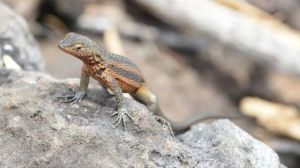London: Nineteen percent of the world’s reptiles are close to extinction, according to a new study.
The study involving more than 200 experts from the Zoological Society of London (ZSL) and the IUCN Species Survival Commission (SSC) is the first of its kind, summarising the global conservation status of reptiles.
These experts assessed the extinction risk of 1,500 randomly selected reptiles from all over the globe.
Of the estimated 19 percent of reptiles threatened with extinction, 12 percent have been classified as critically endangered, 41 percent endangered and 47 percent vulnerable, the journal of Biological Conservation reports.
Three critically endangered species were also highlighted as possibly extinct. One of these, a jungle runner lizard Ameiva vittata, has only ever been recorded in one part of Bolivia, according to a ZSL statement.
Levels of threat remain particularly high in tropical regions, mainly as a result of habitat conversion for agriculture and logging.
With the lizard’s habitat virtually destroyed, two recent searches for the species have been unsuccessful.
Monika Bohm, from ZSL, who led the study, said: “Reptiles are often associated with extreme habitats and tough environmental conditions, so it is easy to assume that they will be fine in our changing world.”
“However, many species are very highly specialised in terms of habitat use and the climatic conditions they require for day-to-day functioning. This makes them particularly sensitive to environmental changes,” Bohm added.
Collectively referred to as ‘reptiles’, snakes, lizards, amphisbaenians (also known as worm lizards), crocodiles, and tuataras have had a long and complex evolutionary history, having first appeared on the planet around 300 million years ago.
They play a number of vital roles in the proper functioning of the world’s eco-systems, as predator as well as prey.
Head of ZSL’s Indicators and Assessment Unit, Ben Collen said: “These findings provide a shortcut to allow important conservation decisions to be made as soon as possible and firmly place reptiles on the conservation map.”
-IANS
The opinions, beliefs and viewpoints expressed by authors, news service providers on this page do not necessarily reflect the opinions, beliefs and viewpoints of Hill Post. Any views or opinions are not intended to malign any religion, ethnic group, club, organization, company, or individual.
Hill Post makes no representations as to the accuracy or completeness of any information on this site page.



